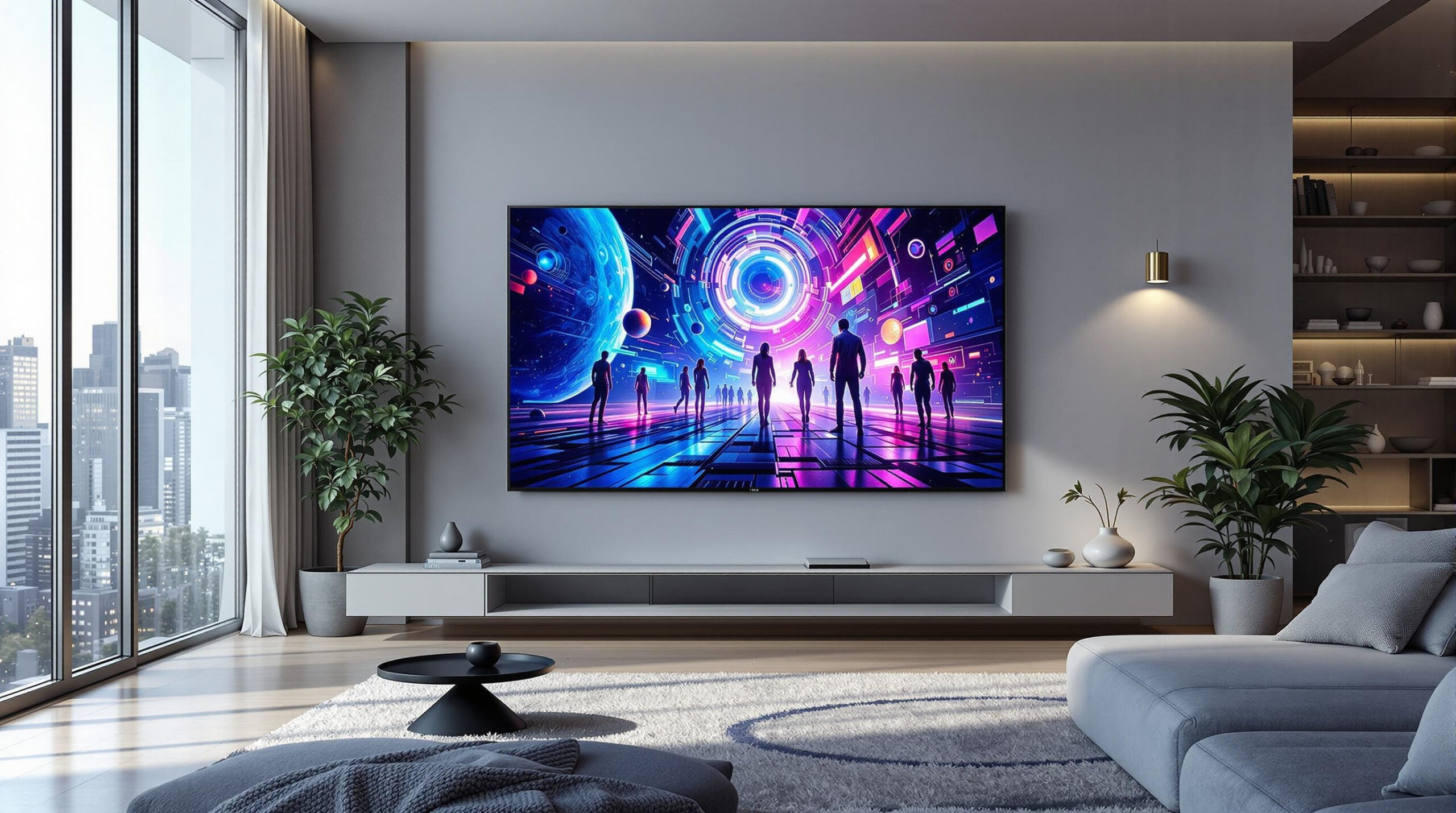Variable Refresh Rate (VRR) sounds like an esoteric checkbox on a spec sheet, yet it is one of the most transformative features to reach modern displays—especially OLED televisions. VRR allows a screen to synchronize its refresh cadence to the fluctuating frame-output pattern of a gaming console or PC graphics card. When that capability is married to the self-emissive, instant-response nature of an OLED panel, on-screen motion looks silk-smooth, tear-free, and strikingly lifelike. Behind the simplicity of a fluid image lies a rigorous dance of physics, chemistry, and electronic engineering. This article deconstructs that dance, showing how VRR works at the signal level, why OLED’s material science gives it a decisive edge, and what challenges engineers must solve to realize hitch-free motion without compromising brightness, color stability, or panel longevity.
The Anatomy of a Frame: Timing Fundamentals
Every display, whether a century-old cathode-ray tube or a cutting-edge OLED, ultimately follows the same cadence: draw, hold (or decay), and repeat. A conventional 60 Hz television redraws the entire raster every 16.67 milliseconds, regardless of how much visual information has changed. If a graphics processor finishes rendering early, it must wait for the next refresh window; if it finishes late, it misses the window entirely, and the previous frame is redisplayed, causing stutter. VRR eliminates that rigidity by turning the panel into an obedient metronome that listens for each new frame signal and only refreshes when data arrive. The display’s timing controller stretches or shrinks the interval between vertical blanking pulses from roughly 8 ms (120 Hz) to 33 ms (30 Hz) and anywhere in between, always in real time.
Variable Refresh Rate Defined
VRR is not a single standard but an umbrella term encompassing several transport-layer protocols—HDMI Forum VRR, NVIDIA G-SYNC Compatible, AMD FreeSync Premium, and VESA Adaptive-Sync among them. Regardless of branding, the core principle is identical: during each scan, the source device can either transmit a new frame or, if it is still busy rendering, hold the video data lines in an idle state. The sink device (the television) monitors the end-of-active-video marker, then decides whether to insert an elongated back-porch interval or trigger the next front-porch and begin scanning a fresh frame immediately. This elasticity abolishes the age-old integer coupling between GPU frame rate and panel refresh rate, letting real-world performance roam freely without incurring judder or tearing artifacts.
How Screen Tearing Happens—and How VRR Prevents It
Screen tearing arises when the graphics source performs a buffer swap halfway through the display’s raster sweep. The top portion of the screen shows part of the old frame, the bottom portion shows the new one, and a disjointed horizontal seam bisects them. Traditional V-Sync can lock the GPU to the panel’s cadence and prevent tearing but, in doing so, re-introduces judder whenever the GPU cannot hit an exact divisor of the refresh frequency. VRR solves both problems simultaneously: the television waits for the GPU’s next finished frame rather than enforcing its own unyielding clock, so every scanout contains exactly one frame with no discontinuities. Because OLED pixels switch states in microseconds, that frame transition looks seamlessly coherent.
The OLED Advantage: Instantaneous Pixel Response
Liquid-crystal displays hold each image sample until the next one arrives, a phenomenon called sample-and-hold. Even with VRR active, a 120 Hz LCD keeps each pixel luminance static for roughly 8 ms, inviting motion blur as a viewer’s eyes track moving objects. OLEDs behave differently. When a subpixel voltage pulse arrives, organic molecules in the emissive layer recombine electrons and holes within tens of nanoseconds, releasing photons immediately. The pixel reaches its target luminance almost instantaneously and can, if instructed by black-frame insertion (BFI) or low-persistence strobing, extinguish itself between refreshes. That transient impulse sharply reduces perceived blur, meaning OLED derives a double benefit from VRR: the motion cadence is smooth, and each step contains crisp, blur-free detail.
Synchronizing Photons and Electrons: Inside the Timing Controller
The timing controller (TCON) is the display’s traffic cop. In a VRR-capable OLED TV, the TCON must accept a variable clock from the HDMI 2.1 or DisplayPort receiver, decide when the blanking interval ends, and instruct the source driver ICs to begin a new row scan. Beneath that macro choreography lies a micro ballet: thin-film transistors (TFTs) address the pixel-level storage capacitors that regulate current through each organic diode. When frame intervals stretch from 8 ms to 22 ms because a demanding game scene drags the GPU down to 45 FPS, the driver must guarantee that per-pixel currents remain stable so luminance does not drift. That involves finely tuned compensation algorithms built into the OLED’s low-level gate-in-panel (GIP) circuitry.
HDMI 2.1, DisplayPort, and the Protocol Layer
HDMI Forum VRR operates by letting the source vary the duration of each frame’s vertical sync interval, so the effective pixel clock derivatives remain within spec while the blanking interval expands or contracts. DisplayPort’s Adaptive-Sync achieves much the same but offers finer granularity and lower mandatory floor frequencies, which is why many PC monitors advertise 48–240 Hz VRR ranges. Internally, OLED smart TVs run these external pixel clocks through a phase-locked loop that generates gate, data, and source driver clocks. Engineers must ensure that the PLL tolerates frequency excursions without losing lock; otherwise, the screen may black out or show white-flash artifacts as the PLL re-synchronizes.
Motion Perception Physics: Blur, Persistence, and Eye-Tracking
Human vision integrates light over roughly 10 ms intervals. When an object moves across the screen, your eyes follow it smoothly, but the display shows a series of discrete images. In a sample-and-hold display, each pixel remains lit for the entire frame, so the brain perceives a smeared trail. Lowering the persistence—either by flickering the backlight as some LCD gaming monitors do or by turning an OLED pixel off between frames—reduces blur. VRR contributes indirectly: because the GPU rarely needs to duplicate frames, the interval between different motion samples stays regular, improving the predictability of motion vectors that your visual cortex reconstructs.
Chemistry Inside the Pixel: How Organic Emitters Handle Rapid Swings
OLED pixels are stacks of organic thin films—hole-transport layers, emissive layers, electron-transport layers—flanked by electrodes. Green and red layers typically use phosphorescent iridium complexes, while blue may use fluorescent or thermally activated delayed-fluorescence (TADF) emitters. These molecules are excited into singlet or triplet states whenever current flows; they relax and emit photons, then return to the ground state. Because these excitations occur on nanosecond timescales, the chemistry itself imposes no bottleneck on refresh rate. What does matter is thermal load and exciton density: high-frame-rate VRR gaming at 120 Hz keeps average current elevated, which can accelerate quenching or generate point defects. Modern panels use deuterated blue emitters and optimized host–guest matrices to mitigate the stress, and firmware periodically runs compensation cycles to even out wear.
Engineering Challenges: Luminance Stability, ABL, and Near-Black Flicker
OLED TVs are subject to Automatic Brightness Limiter (ABL) circuits that cap full-field luminance to meet power and thermal limits. Under VRR, the instantaneous duty cycle of bright frames can vary erratically; if ABL reacts too slowly, brief overshoots cause flashing or global dimming artifacts. Engineers therefore tie ABL control loops to frame timing, shortening their attack time so the limiter adapts on a per-frame basis. Another challenge is near-black flicker: at low grey levels, the current required to sustain emission nears the TFT threshold voltage. Small timing jitter under VRR can modulate that current, making dark scenes pulse. Premium panels solve this by raising bit-depth precision in the 0–5 nit range and compensating gate-off leakage.
Gaming and Cinema Use Cases
Gamers benefit most obviously from VRR. Fast-paced shooters running at 80 FPS on an OLED TV track every camera pan without tearing, and the panel’s sub-millisecond response eliminates ghosting. Film aficionados also gain: next-generation UHD Blu-ray players and streaming boxes can output 24 FPS content while the TV refreshes at 24 Hz, eradicating 3:2 pulldown judder. When menu overlays appear, the output may jump to 60 Hz; VRR lets the screen switch cadence invisibly. Future sports broadcasts captured with variable-frame-rate cameras could likewise map one-to-one onto an OLED’s refresh engine, ensuring live motion looks razor-sharp.
Power Consumption and Thermal Management Under VRR
Running at lower average frame rates can cut panel power draw significantly. A GPU locked to 60 Hz outputs 60 frames even during static scenes; with VRR, it may idle at 40 Hz, allowing the OLED driver to lower its global gate and source voltages and reduce heat dissipation in the organic stack. Television firmware tracks these statistics, dynamically allocating saved thermal headroom to short-lived HDR peaks so highlights retain their punch without violating panel temperature budgets. Hall-effect or infrared sensors embedded in the module provide feedback, letting the system throttle gracefully if a marathon gaming session starts to overheat the upper enclosure.
The Future: 240 Hz OLED, VRR over Wi-Fi, and Emerging Standards
Panel makers are already demoing 27-inch QD-OLED monitors with native 240 Hz capability, requiring the TCON to scan an 11-millisecond frame in just 4 ms when the GPU surges. Extending that technology to 55- and 65-inch televisions will demand multi-chip source driver arrays with equalized skew and novel oxide TFT backplanes that switch faster while retaining low leakage. On the connectivity front, the Wi-Fi Display Extension in Wi-Fi 7 introduces Adaptive Sync metadata, hinting at cable-free VRR streaming in the living room. Meanwhile, the VESA ClearMR standard and HDMI QMS (Quick Media Switching) aim to quantify blur and cut blackouts when frame rates shift, complementing VRR’s raw mechanics with seamless source-change experiences.
Conclusion: Harmonizing Silicon, Molecules, and Human Perception
Variable Refresh Rate is far more than a bullet point for gamers; it is a systemic upgrade that touches every layer of display technology. At the protocol level, it demands agile blanking intervals and rock-solid clock recovery. In the driver stack, it requires compensation algorithms that keep OLED pixels uniform across wildly changing duty cycles. At the material level, it leans on organometallic chemistry able to emit light at microsecond speeds without fatigue. Above all, VRR lets OLED realize its destiny as the ultimate canvas: instantaneous, perfectly synchronized, and free from the temporal artifacts that have plagued moving images since the dawn of electronic cinema. The next time a race car blazes across your OLED screen with no tear line, remember that beneath that effortless image is a symphony of photons, electrons, and molecules operating in lockstep with the whims of your graphics processor—proof that, when engineering disciplines converge, the result can feel like magic.
OLED TV Reviews
Explore Philo Street’s Top 10 Best OLED TV Reviews! Dive into our comprehensive analysis of the leading OLED TV products, complete with a detailed side-by-side comparison chart to help you choose the perfect protection for your devices.




